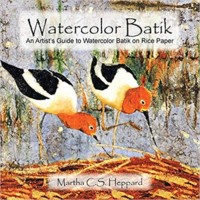Title: Watercolor Batik
Subtitle: An Artist’s Guide to Watercolor Batik on Rice Paper
Author: Martha C.S. Heppard
Publisher: XlibrisUS
ISBN: 978-1-4990-8090-2
Pages: 80
Genre: How-To-Book / Art
Reviewed by: Martha Prouty
Pacific Book Review
Award-winning artist and now author, Martha C.S. Heppard peels the wax – layer by layer – instructing readers precisely how to create exquisite batik paintings using, as the title implies, watercolors on rice paper.
Watercolor Batik, An Artist’s Guide to Watercolor Batik on Rice Paper begins with familiarizing the readers to the basic elements of creating a painting; from sketching to the final step of removing excess wax. A precise description of the paints, types of wax, paper, brushes and tools are unambiguously explained. Even setting up the work space, such as she did on her kitchen table, or studio bench, is told so as not to damage surfaces with the heated wax drippings. The use of an instrument called the tjanting was new to me; as this is a pen-like device used to drip a narrow line of wax for detailed work, or for a signature. The methodology of layering colors, applying background details while keeping space clear for foreground images was very impressive in her expert reveal. Even the end of the book has a glossary of terms so as not to allow for any uncertainty in her conveying the process to readers.
Batik is an art form in which viewers largely do not appreciate all of the work which goes into the creation of a painting. Mostly known for its use on fabrics, the various weights of rice paper mostly ranging from 11 to 36 grams, as explained by the author, absorbs the watercolors and wax in very unique ways, allowing for the dimensional colorization and softness of backgrounds. The emergence of a completed work being formed was surprising to me; as for example, Heppard’s painting called “Cherries Jubilee” jumps out above the background from two white kidney-bean shapes in which I could not anticipate where or how she was going to finish this piece. Other examples follow, such as two birds on a tree branch in “Breakfast Time” in which she shows the sequencing of the various steps with acumen of attention worthy of a teacher instructing her students. This step-by-step reveal of her mastery of skill resulted in a “wow-factor” to me when paging this amazing genre of painting.
Batik seems to be a three multi-dimensional medium which results in a two-dimensional completed painting, due to the final removal of the wax. The results are awesome and captivating, however I am sure the honing of one’s skill will take many years to achieve the level of Heppard’s. Yet, that said, Watercolor Batik, An Artist’s Guide to Watercolor Batik on Rice Paper is a quick-start guide, whereas her years of developing techniques can be grasped within the pages of this invaluable instructional publication. It should be noted the words “Watercolor Batik” have been trademarked and belong only to this author, as others are infringing on her intellectual property. Also, only she uses Japanese rice paper, as others use various paper stocks.
More than a book of beautiful paintings, it is the secret of how she achieved her results which makes this a truly inspiring book for artists from beginners to advance.


